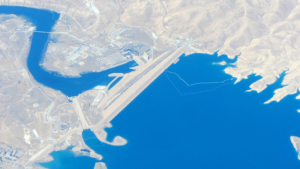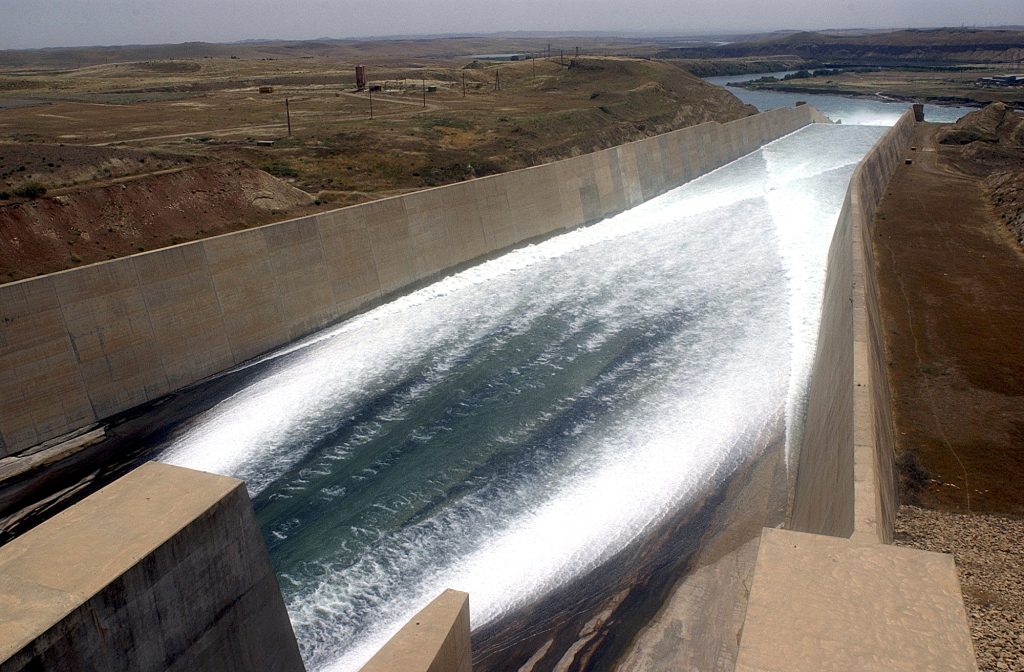Chapter 2
Water Security Issues in Focus: A Case Study of Mosul Dam
By Haytham Oueidat
The Mosul dam is an example of the critical role of water infrastructure for the Middle East in its current unrest. Built between 1981 and 1984, the Mosul dam has spent a fair amount of time in the headlines over the last several years given its centrality in the political instability of Iraq. This section provides a brief history, examines its current issues, and discusses their possible ramifications.
Construction on the Mosul dam began in 1981 when a German-Italian consortium was hired by Saddam’s government to complete the project. The dam was completed in 1984, and in 1985 it began to inundate the Tigris, forming the Mosul Dam Lake reservoir. The dam was constructed in order to support irrigation projects, to produce hydroelectric power for the surrounding areas and to prevent flooding along the Tigris. The dam started producing power in July of 1986.
The Mosul dam stores approximately 11 million cubic meters of water. 8 million cubic meters of this water are actively used to irrigate and supply electricity to the surrounding areas. The dam supplies about 1.7 million people with its three power stations. The dam is approximately 113 meters tall and 3.4 kilometers wide, or 371 feet and 2.1 miles, respectively.

There is a significant flaw in the Mosul dam design, however, which is its poor foundation. The dam itself is situated atop a base of soluble gypsum and is thus incredibly vulnerable to the effects of erosion. This issue was brought up during the course of construction. According to the US Army Corps of Engineers the dam should have had an inverted pyramid foundation in order to control the seepage of water and the effects of erosion. But in order to speed up the construction project the proper foundation was never laid.
Because of the weak material the dam was built on, it requires near constant maintenance and repair. The seepage and erosion are held at bay by injecting grout into the foundation of the dam. Grout is a mixture of water, cement and sand. This substance is pumped into the cavities that form beneath the base of the dam. Local engineers continue to maintain the foundation in this way, despite situational pressures.
Between 1992 and 2004, multiple sinkholes opened up in the area around the dam and downstream, indicating significant erosion in the area. Additionally, during the course of the American war in Iraq there were several bombings in the area around the Mosul dam, one even damaging some of its outer infrastructure. It was also during this time that foreign observers began to raise the issue of the dam’s viability. Iraqi officials at the time denied any significant issue with the dam or its maintenance.
Since the American invasion of Iraq there have been several options explored by which the Mosul dam could be shored up or repaired. The first solution would be to potentially drain the reservoir, Mosul Dam Lake. This would avert a major catastrophe should the dam collapse. If the dam were to collapse and the reservoir was full the city of Mosul could be under 20 meters of water in less than a few hours, with major flooding occurring down river all the way to Baghdad where the estimated flood waters would reach 10 meters high. This would displace millions, cause irreparable damage to infrastructure and agriculture and set the country of Iraq back decades.
The second option would be to plug the foundation. This option would essentially shore up the eroding base of the dam, but it would not be a long term option. Over time the seepage would continue to erode whatever substance was used to plug the foundation, essentially just forestalling the issue. The third option would be to add a slurry wall to the dam to reinforce its structural integrity. Both options would be costly and neither would solve the real source of the problem, the soluble gypsum foundation.
In more recent years the viability of the Mosul dam has moved from an environmental and construction issue to a national security threat for the state of Iraq. In July and August of 2014 the Mosul dam was seized by fighters from the so-called “Islamic State”. For a period of time there was intense fighting in and around the dam, with much of it being extensively covered on the news. The fear of the international community was that the Islamic State was going to use the Mosul dam for several purposes. Firstly, it was feared that ISIS would cut water flow south and shut off the hydropower plants in order to deny the people of Iraq the water and electricity they needed.
The second and much more potent fear was that ISIS was going to destroy the dam and use the ensuing flooding as a weapon against Iraq. As previously mentioned, the flood waters could have been as high as 20 meters in Mosul and as high as 10 meters in Baghdad, with millions affected.
Thankfully neither of these scenarios played out. The Islamic State only held the Mosul dam for two weeks before Kurdish forces drove them out with US-coalition air support. Since then the dam has remained safely in government hands. While crisis had been avoided it highlighted one of the most recent and dangerous problems facing the riparian states, the damaging of water infrastructure by extremist groups.
In Syria, the Islamic state controls the Tabqa dam, one of the vital dams along the Euphrates river. The Islamic State could use this dam in a manner similar to that of Mosul’s. They could cut off the flow of the river, shut down the hydropower plants or flood the areas downstream, all of which could have irreversibly catastrophic humanitarian or environmental ramifications.
A dam being controlled by the extremist group, or any non-government group for that matter, presents a myriad of technical issues and potential for catastrophic failure. The staff at Mosul abandoned the dam out of fear for their lives when ISIS seized it. This meant that for two weeks the dam which requires daily repair went without that care taking. That two-week period of ISIS occupation presented the country of Iraq with the very real possibility of the dam’s unexpected failure.
The government of Syria has this issue to contend with as well, given that its engineers and professionals who are uniquely qualified to care for its water infrastructure are under increasing pressure to flee. It is noteworthy that these engineers often stay on, regardless of who is in power because they understand their duties. Both governments struggle to devote the resources necessary, however, for maintenance during this period of instability. This creates a host of additional security risks and challenges.
In order for riparian cooperation to continue, and for the proper rehabilitation of the water infrastructure in both Iraq and Syria, a period of stability is required. The longer the political instability and violence hold sway in the region, the greater the chance that a malfunction occurs somewhere which leads to large scale flooding and untold humanitarian and environmental costs. These issues were highlighted during the two-week battle for Mosul dam back in 2014, and they will continue to be an issue until peace is reached in the region.


Feedback/Errata